To prevent knife injuries, follow proper handling standards like gripping the handle firmly, curling your fingers away from the blade, and cutting away from your body. Use ergonomic techniques to reduce strain, wear appropriate protective gear, and keep your workspace organized. Regular safety training and updates help reinforce best practices. Staying attentive and practicing these techniques consistently can greatly reduce risks. Keep exploring these guidelines for safer, more confident knife use.
Key Takeaways
- Establish clear safety protocols and standard operating procedures for proper knife handling and passing techniques.
- Provide comprehensive training on ergonomic grips, cutting angles, and safe workspace organization.
- Use appropriate PPE, such as cut-resistant gloves and protective clothing, to minimize injury risk.
- Regularly review, update, and reinforce safety guidelines through workshops and refresher courses.
- Implement immediate injury response procedures and promote a safety culture to prevent accidents.
Understanding the Importance of Proper Knife Handling
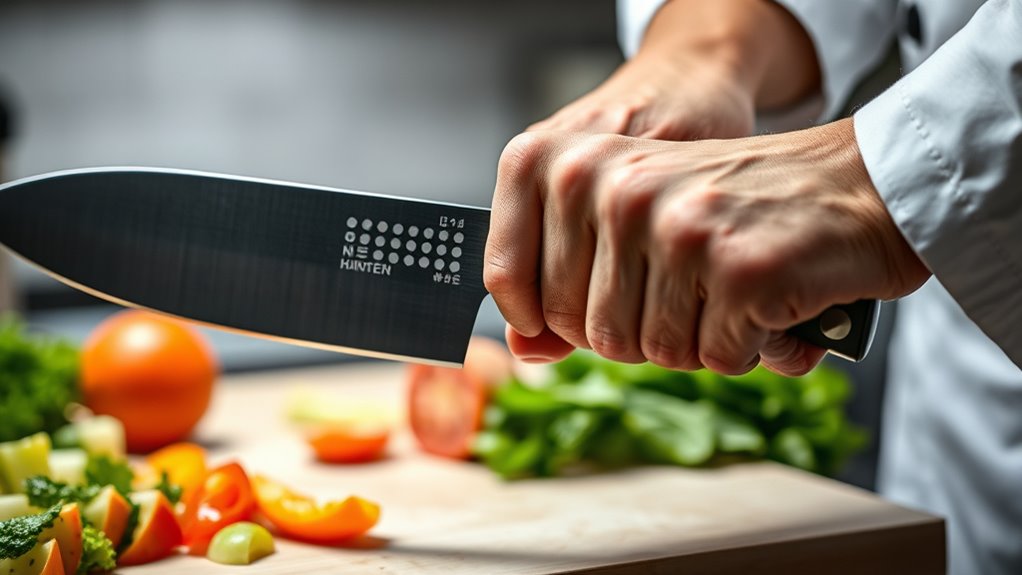
Understanding the importance of proper knife handling is essential for ensuring safety and efficiency in the kitchen. When you handle knives correctly, you reduce the risk of accidents and injuries, protecting yourself and others around you. Proper technique helps you maintain control over the blade, making cutting tasks smoother and more precise. Using the right grip and cutting motions minimizes strain and fatigue, allowing you to work faster without sacrificing safety. Additionally, handling knives properly prolongs their lifespan, preventing damage caused by misuse. Remember, a well-maintained knife used with proper technique is safer and more effective. Developing good habits now ensures you can work confidently in any kitchen environment, whether you’re preparing a simple meal or a complex dish. Knife‑handling standards play a crucial role in maintaining safety and performance during food preparation.
Common Causes of Knife-Related Injuries

Many common accidents in the kitchen happen because of improper knife handling. One major cause is rushing, which leads to losing control or cutting too close to your fingers. Distractions, like chatting or multitasking, also increase the risk of slips. Using dull knives forces more force, making slips more likely. Improper grip or positioning can cause the knife to slip unexpectedly. Cutting on unstable surfaces or using the wrong cutting technique contributes to injuries. Sometimes, people try to catch a falling knife or leave knives in sinks or dishwashers, increasing the chance of accidental cuts. These careless habits create dangerous situations. Recognizing these common causes helps you stay alert and develop safer practices, reducing your risk of injury while working with knives. Proper knife maintenance and using the right tools can further improve safety during food preparation.
Essential Knife Handling Techniques for Safety
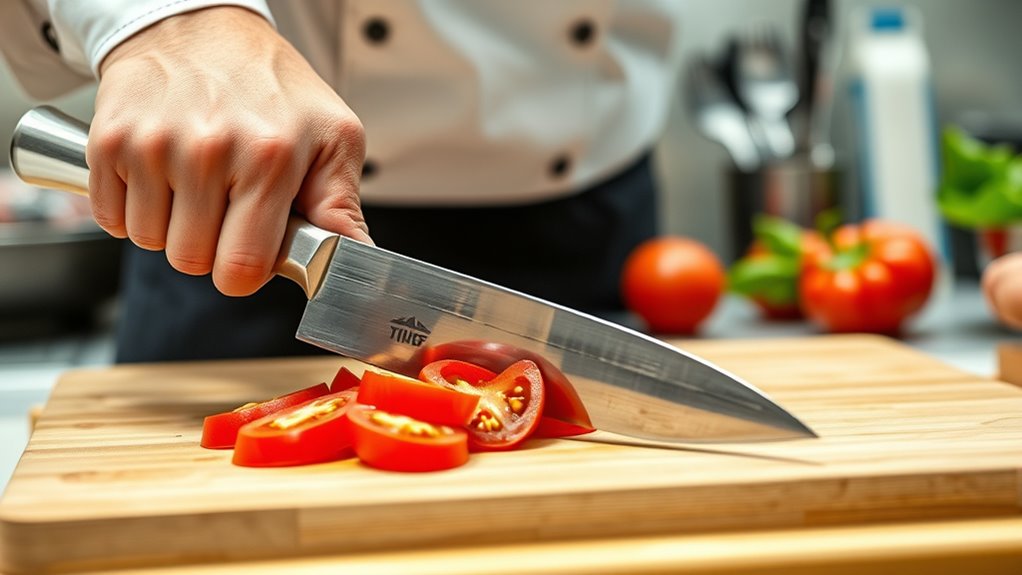
To handle knives safely, you need to master a few essential techniques that keep you in control and reduce the risk of injury. First, always grip the handle firmly, but not too tight, to maintain steady control. Keep your fingers curled inward on the hand holding the knife, away from the blade’s edge. Use a proper cutting motion—rocking the knife smoothly back and forth—rather than applying excessive force. When chopping, use a stable, non-slip surface and keep your guiding hand’s fingertips tucked under your knuckles to protect them. Pay attention to your cuts, maintaining focus and avoiding distractions. Always cut away from your body, and never attempt to catch a falling knife. Additionally, understanding the contrast ratio of your projector can help ensure optimal image quality for your viewing environment. Mastering these techniques helps prevent accidents and promotes safe, efficient knife handling.
Standard Personal Protective Equipment for Knife Work
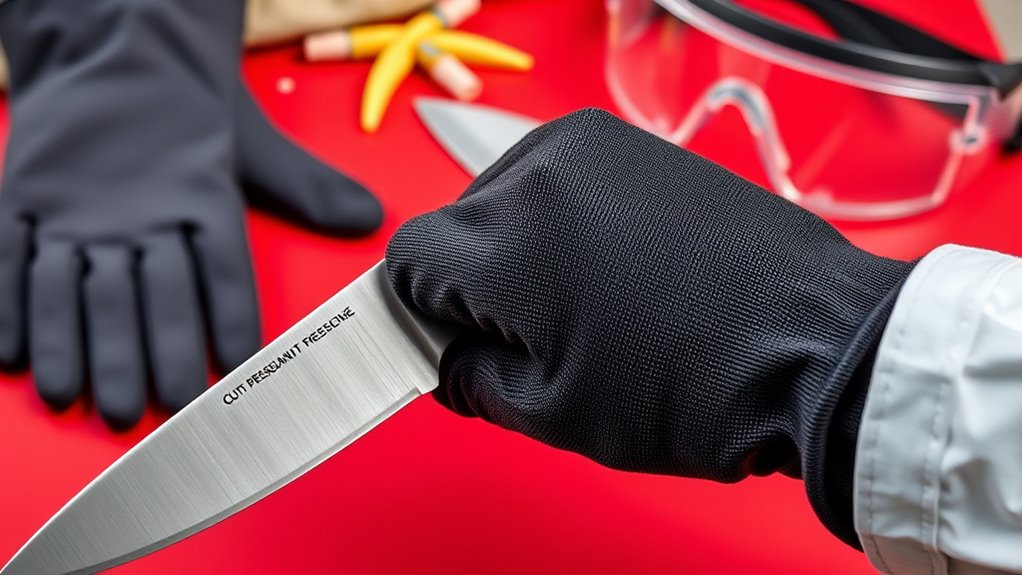
Wearing the right personal protective equipment is essential for safe knife work. You need to choose proper gloves made from cutting-resistant materials to protect your hands. Additionally, wearing protective clothing helps prevent injuries and maintains safety standards during handling. Incorporating artistic elements into your protective gear can also improve visibility and comfort during prolonged use.
Proper Gloves Selection
Have you chosen the right gloves for knife work? Proper gloves are essential to protect your hands and improve grip. Look for gloves that fit well, offer flexibility, and are made from materials suitable for your task. Avoid gloves that are too bulky, which can hinder precision, or too thin, which might not provide enough protection. Here’s a quick overview:
| Glove Type | Material | Best Use |
|---|---|---|
| Cut-resistant | Kevlar, HPPE | High-risk cutting tasks |
| Nitrile | Nitrile rubber | Chemical resistance, grip |
| Vinyl | PVC | Light protection, hygiene |
| Leather | Leather | Heavy-duty, durability |
| Fabric | Cotton/Polyester | Comfort, general use |
Choose gloves that match your activity, ensuring safety without sacrificing dexterity. Additionally, selecting gloves that comply with safety standards can further mitigate injury risk.
Cutting-Resistant Material Use
Using cutting-resistant materials is vital for guaranteeing your safety during knife work. These materials act as a barrier between your hands and the blade, markedly reducing the risk of cuts. When selecting gloves or sleeves, choose those made from high-quality fibers like Kevlar, Dyneema, or steel mesh, which are tested for cut resistance. Always ensure the protective gear fits snugly without restricting your movement or dexterity. Proper use of cutting-resistant materials allows you to handle knives confidently while maintaining control. Remember, even the best materials aren’t foolproof; they are a key part of your safety protocol. Regularly inspect your gear for wear and tear, replacing it as needed to maximize protection during every task. Incorporating patch testing can help ensure your protective equipment is suitable for your skin sensitivity and reduces the risk of irritation.
Protective Clothing Significance
Protective clothing plays a crucial role in minimizing injuries during knife work by providing a physical barrier between you and potential cuts. Wearing appropriate gear, like cut-resistant gloves, aprons, and sleeves, reduces the risk of deep lacerations and punctures. These items are designed to withstand knife impacts, preventing blades from penetrating your skin. Proper protective clothing also keeps your clothes clean and free from contamination, especially in food processing or medical environments. Remember, no single piece of gear offers complete safety, but combined, they substantially lower injury chances. Always choose high-quality, certified protective clothing suited to your specific tasks. Regularly inspect your gear for damage, replacing worn or compromised items immediately. Your safety depends on consistent use and proper maintenance of your protective clothing. Incorporating safety precautions such as proper training and awareness further enhances injury prevention during knife handling.
Developing and Implementing Safety Protocols

To guarantee safe knife handling in any setting, developing clear and effective safety protocols is essential. You need to establish guidelines that everyone understands and follows consistently. Start by evaluating potential hazards and creating specific procedures to address them. Make sure protocols cover proper grip, cutting techniques, and safe handling when passing knives. Regularly review and update these protocols to adapt to new risks or equipment. Communicate clearly with your team, ensuring everyone knows their responsibilities. Consider implementing checklists or visual cues to reinforce safety practices. Consistency is key—everyone should follow the same standards to minimize accidents. Incorporating proper storage methods and ensuring knives are kept securely when not in use can further prevent injuries.
Training and Education for Safe Knife Practices
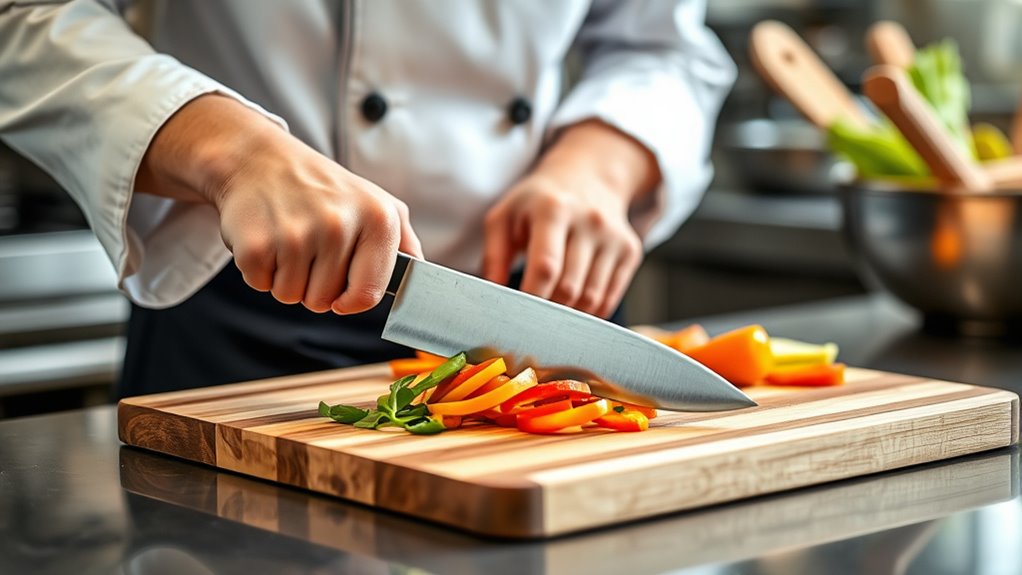
Effective training and education are essential for ensuring everyone understands and consistently applies safe knife practices. When you receive proper instruction, you learn essential techniques like proper grip, cutting angles, and safe passing methods. Hands-on training helps build muscle memory, reducing the risk of accidents. Regular workshops, demonstrations, and refresher courses keep safety at the forefront. Encourage open communication about potential hazards and safe handling tips. Clear guidelines and practical exercises foster confidence and competence. You should also learn how to recognize unsafe behaviors and correct them promptly. Consistent education creates a safety culture where everyone is responsible for themselves and others. Ultimately, well-designed training programs empower you to handle knives safely, minimize injuries, and promote a safer working environment.
Ergonomic Considerations to Minimize Risks
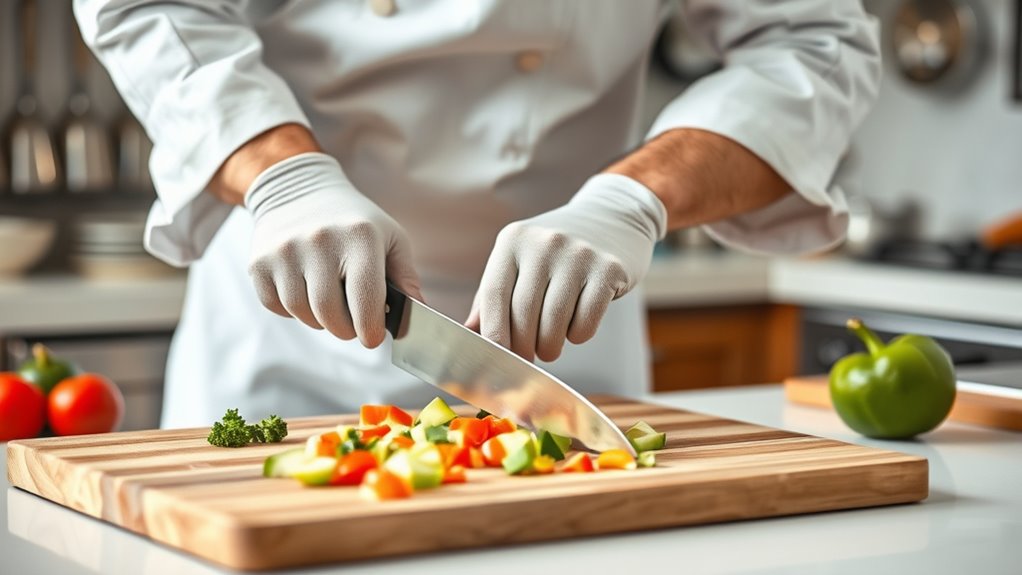
Proper ergonomic design plays a crucial role in minimizing risks when handling knives. When your workspace and tools are ergonomically optimized, you reduce strain and improve control, lowering the chance of accidents. Focus on choosing knives with comfortable, non-slip handles that fit your hand well. Maintain proper posture to prevent fatigue and muscle tension during extended use. Make certain your workspace is at an appropriate height to avoid awkward angles. Regularly taking breaks helps prevent repetitive strain injuries. Additionally, consider these ergonomic tips:
Proper ergonomic design reduces strain and enhances safety when handling knives.
- Use knives with balanced weight distribution for better control
- Keep your workspace organized to avoid unnecessary reaching
- Adjust your grip to reduce pressure points and enhance stability
- Incorporate ergonomic practices to further minimize strain and improve safety.
Implementing these considerations helps you handle knives safely and efficiently, decreasing injury risk.
Strategies for Emergency Response and Injury Management
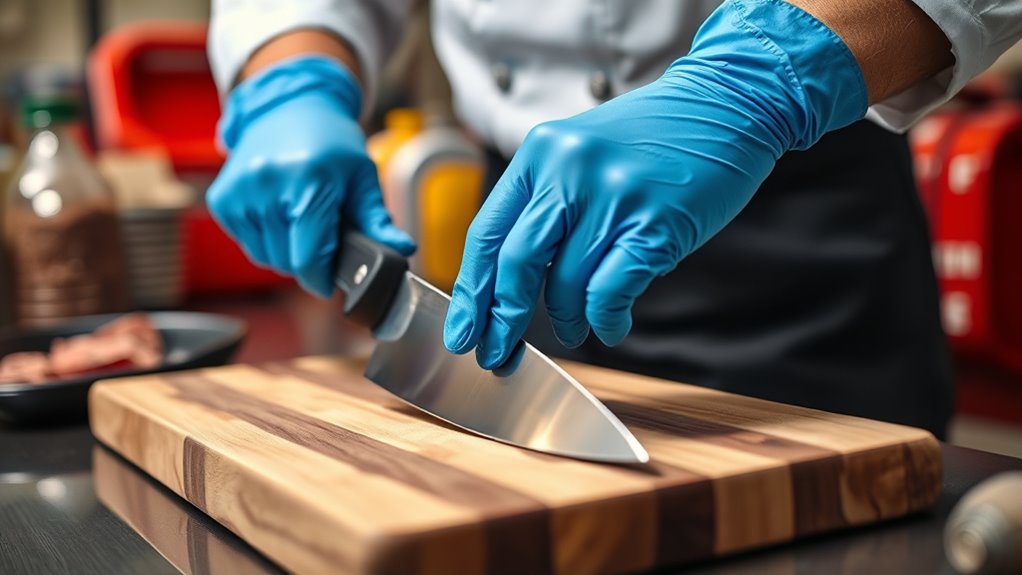
When a knife injury occurs, quick and calm action can considerably reduce the severity of the harm. First, stop the bleeding by applying firm pressure with a clean cloth or bandage. Keep the injured area elevated to slow blood flow. Avoid removing any embedded objects; instead, stabilize them and seek medical help immediately. If the wound is severe or bleeding persists, call emergency services without delay. While waiting for help, monitor the injured person for shock symptoms—pale skin, weakness, or confusion—and keep them warm. Reassure them to stay calm. Do not give them food or drink, and avoid applying ointments or tourniquets unless instructed by medical professionals. Proper knife-handling standards and injury management techniques are essential to minimize harm. Prompt, composed response minimizes damage and can save lives.
Frequently Asked Questions
How Often Should Safety Training Be Refreshed for Knife Handling?
You should refresh safety training for knife handling at least annually to guarantee skills stay sharp and risks stay low. Regular updates help reinforce proper techniques and keep you aware of any new safety protocols. If you notice any unsafe habits or have experienced recent injuries, consider more frequent refreshers. Staying current with training helps prevent accidents, protects you, and maintains a safe working environment.
What Are the Legal Requirements for Injury Reporting in Knife-Related Incidents?
Imagine a small cut turning into a bigger problem because it wasn’t reported. You’re legally required to report knife-related injuries promptly, often within 24 hours, depending on your jurisdiction. This helps ensure proper treatment and prevent future incidents. Failing to report can lead to fines or penalties. Stay vigilant—report every injury, no matter how minor, to safeguard yourself, coworkers, and everyone’s safety.
How Do Different Knife Types Affect Handling Safety?
Different knife types impact handling safety because their design influences how easily and safely you can use them. For example, serrated knives require more caution due to their cutting power, while smaller or lighter knives are easier to control. You should always choose the right knife for the task and handle it carefully. Proper handling reduces risks, prevents injuries, and guarantees safe use regardless of the knife’s type.
Are There Specific Standards for Knife Storage in Workplaces?
Imagine a tidy toolbox where each tool has its cozy spot—that’s how workplaces should handle knife storage. Yes, there are specific standards, like using designated, secure containers or drawers that keep blades out of reach when not in use. These guidelines help prevent accidents, ensuring knives are stored safely and organized. Following these standards keeps everyone’s workspace safe and reduces the risk of unintended injuries.
How Can Technology Improve Injury Prevention in Knife Use?
Technology can considerably improve injury prevention when you handle knives. For example, smart knife blades with sensors can detect improper grip or excessive force, alerting you instantly. Safety gloves with embedded sensors can warn you before a cut occurs. Additionally, automated storage systems ensure knives are stored securely and organized, reducing accidental injuries. Embracing these innovations helps you work more safely and confidently with knives.
Conclusion
By mastering mindful knife handling, you minimize mishaps and maximize safety. Remember, proper protocol, protective gear, and persistent practice paint a powerful picture of prevention. Stay vigilant, value education, and prioritize your well-being to prevent painful injuries. With consistent caution and committed care, you create a safer space where skill and safety seamlessly synchronize, safeguarding yourself and those around you. Protect your hands, practice prudence, and promote a safer, sharper tomorrow.









